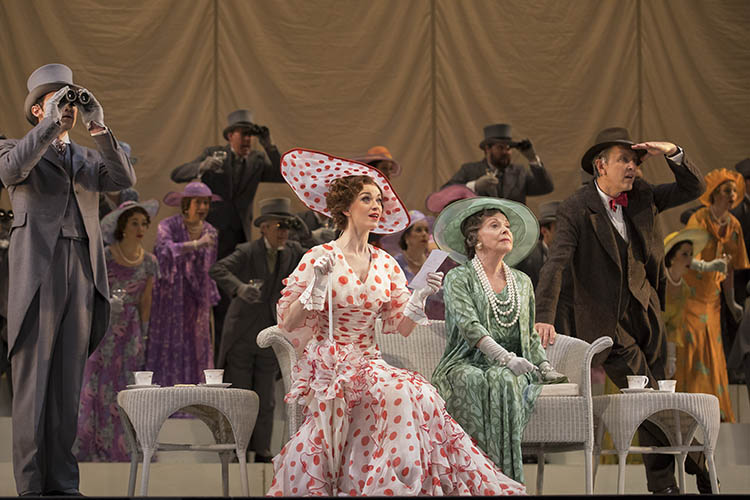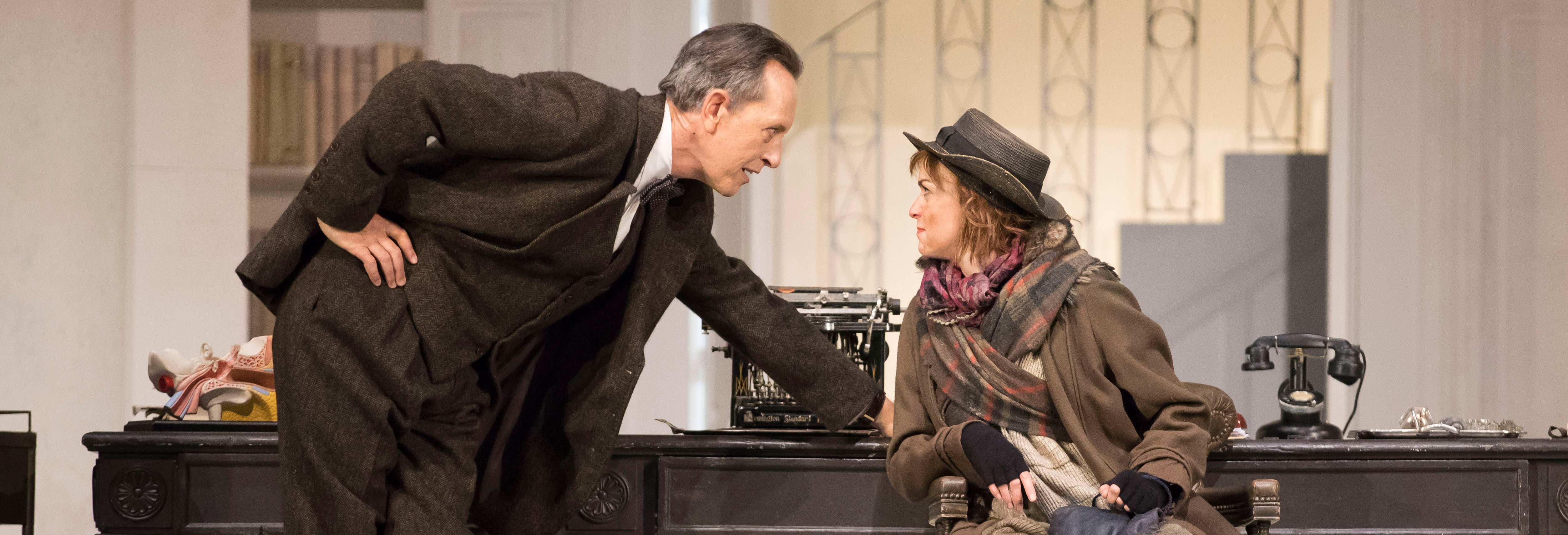May 28, 2020
MY FAIR LADY: Almost—but not quite—A love story
Alan Jay Lerner and Frederick Loewe’s My Fair Lady has thrilled audiences around the world since its 1956 premiere. Its memorable songs—“I Could Have Danced All Night,” “On the Street Where You Live,” “The Rain in Spain,” and many more—have made their way into the lives of millions, capturing hearts of all ages. The evolution of this masterpiece, while immensely challenging to its creative team, was wildly successful and rewarding for them all—a musical that truly illuminated and enhanced one of the most captivating plays and films in the English language.

Bryce Pinkham, Lisa O'Hare, Helen Carey, and Richard E. Grant in Lyric's 2016/17 My Fair Lady production.
Lerner and Loewe were already successful on Broadway (Brigadoon, Paint Your Wagon) by 1952, when the idea of a musical version of George Bernard Shaw’s Pygmalion was suggested to them. The instigator, film producer-director Gabriel Pascal, had previously fashioned brilliant film adaptations of four Shaw plays—Pygmalion, Major Barbara, Caesar and Cleopatra, and Androcles and the Lion. At first the task proposed by Pascal seemed too daunting (Rodgers and Hammerstein had previously made the attempt and given up); after all, how could anyone create a great contemporary musical without a love story? Lerner and Loewe abandoned the project, but after Pascal’s fruitless pursuit of Noël Coward and Cole Porter—two other musical-theater greats—they began again, starting work shortly after Pascal’s death in mid-1954.
With the ever-present problem of an unromantic plot, the duo finally achieved a breakthrough in realizing that, as Lerner later explained, they “could do Pygmalion simply by doing Pygmalion.” The foundation for their work would be the superb screenplay written by Shaw himself for Pascal’s 1938 film. This meant a copious amount of dialogue, but Lerner insisted on retaining as much Shaw as possible. Shaw’s characters were certainly strong and dynamic enough to stand on their own; Lerner and Loewe’s great challenge was to create transitions that would compel them to express themselves through song.
The development of the score was still at a comparatively early stage when Broadway superstar Mary Martin and her husband, producer Richard Halliday, caught wind that a musical Pygmalion was in the works. They requested a preview, but after hearing some of the songs, the couple left without saying a word. Halliday later told Lerner and Loewe that Martin had paced back and forth all night muttering, “Richard, those boys have lost their talent.”
While attacking the thorny task of obtaining the rights to produce their show, the duo searched for a leading lady, now that Mary Martin was out of the picture. Attending a performance of Sandy Wilson’s 1920s-style Broadway musical hit, The Boy Friend, Lerner and Loewe first laid eyes on an exceptionally poised 19-year-old English singer-actress. Her name was Julie Andrews, and in voice, diction, presence, and beauty she was exquisite. Lerner asked her to stay on call and not accept another project until they could confirm the rights to the show, and Andrews graciously agreed. Now that an ideal Eliza Doolittle was waiting in the wings, the duo needed to locate her leading man.

Lisa O'Hare as Eliza Doolittle in Lyric's 2016/17 My Fair Lady.
Though Noël Coward was thought of as a possibility, for Lerner there was only Rex Harrison, whom he considered the quintessential Prof. Henry Higgins. In 1955 the librettist and composer flew to London to secure the rights to produce the show, but also to meet with Harrison. After his performance in John Van Druten’s comedy Bell, Book, and Candle in the West End, they found a piano to show the actor two of the completed numbers for Higgins: “Lady Liza” and “Please Don’t Marry Me” (neither actually ended up in the final production). Harrison was hesitant to sign on; he disliked the music and was unconvinced of Lerner’s clever word games. An even more serious problem—Harrison wasn’t a singer! He was also nervous about following in the footsteps of Leslie Howard in Pascal’s film, but having been assured that he was the best possible choice, Harrison decided to think it over. After a few days, he confirmed with Lerner and Loewe that he would play Higgins. His utterly distinctive half-singing/half-speaking style would ultimately leave an indelible mark on the role.
The introduction of Eliza’s father into the story developed as an aside from Shaw’s original concept. The team decided to show what happened to Eliza between her meeting Higgins at Covent Garden and her arrival at his house the next morning. They imagined a scene in which the flower-girl—having been tossed a good bit of money by Higgins—is cajoled by her father into tossing him a coin or two. Alfred P. Doolittle is an incorrigible yet lovable man, reveling in the “good life” of avoiding work and marriage while pursuing drink and philandering. Lerner and Loewe knew that London-born Stanley Holloway, with his experience as a comic monologist who’d also acted in two of Pascal’s Shaw films, would be perfect as Doolittle.

Donald Maxwell and the cast of Lyric's 2016/17 My Fair Lady.
After securing funding for production from CBS, the musical had everything in place—except a director and a title. The first problem was solved after Moss Hart, a major player on Broadway as both playwright and director, heard half a dozen of the songs. As for the title: Lerner and Loewe did not want to call the musical Pygmalion, as it sounded too much like just a revival. My Fair Lady was originally rejected, since the duo considered it too operetta-ish. Other names were thought over, such as Liza, Lady Liza, Come to the Ball, The Talk of London, and Fanfaroon (British slang for “braggart”), but by the summer of 1955, the title My Fair Lady had stuck. As it turned out, in 1925 Ira Gershwin had written a musical of the same name that was then renamed Tell Me More. Out of courtesy, Lerner made a call to Gershwin to inform him that he and Loewe would be using the title.
The creative process proved difficult; however, it helped that, with the deaths of both Shaw and his friend Pascal, Lerner and Loewe then felt comfortable allowing themselves some artistic liberties, although they stayed true to the spirit of Shaw’s story. Shaw himself included some elaborations on his original play when adapting it for film, and Lerner and Loewe did the same for their musical (especially as regards Mr. Doolittle: his appearances in both his first scene and then in Act Two—the scene featuring his boisterous 11 o’clock number “Get Me to the Church on Time”—don’t appear in Shaw.) But when it came to the matter of the love story—or lack thereof—Lerner and Loewe had a problem: how to write what amounts to an almost-love song? The answer would be found in the pages of Shaw’s drama.
In the final act of Pygmalion, Eliza makes the decision to leave and marry Freddy, now that her lessons in speech are over. She tells Higgins firmly that he’ll have to do without her. In response, Higgins shows a bit of vulnerability, saying, “And I’ve grown accustomed to your voice and appearance. I like them, rather.” It was from these very words that Lerner and Loewe were inspired to write “I’ve Grown Accustomed to Her Face,” certainly one of the show’s most memorable songs. In this, the last of his four solo numbers, Higgins expresses an emotional ambivalence—in fact, a genuine inner turmoil—over Eliza’s impending marriage to Freddy. He alternates between quietly reflecting on his feelings for the girl and gleefully predicting that she’ll soon come crawling back to him. It was in the song’s main theme that Lerner and Loewe developed the memorable “almost-love song” they’d searched for; it became one of Broadway’s most frequently recorded and performed songs, covered by the likes of Johnny Mathis, Dean Martin, and even Kermit the Frog (!), to name just a few of its interpreters.

Richard E. Grant and Lisa O'Hare in Lyric's 2016/17 My Fair Lady.
Now it was time to develop a similarly revealing song for Eliza. Loewe actually wrote the melody for “I Could Have Danced All Night” in a single day. The following day Lerner presented him with the finished lyric, in which we can sense her suppressed feelings for Higgins. Interestingly, Lerner was unhappy with one particular line—“Why all at once, my heart took flight”—he felt what he referred to as a “special loathing” for songs in which someone’s heart took on anthropomorphic qualities. But he got over his reluctance: the phrase remained, and this exhilarating, show-stopping number went on to become arguably the most beloved song in My Fair Lady.
The absence of a typical love song doesn’t divorce the show from romance completely; there is, after all, Freddy’s “On the Street Where You Live” (even Shaw declared in his afterword that once Pygmalion was over, Freddy and Eliza married), and in fact, Eliza’s return to Higgins—not part of Shaw’s original play—constitutes the final moments of both the film and the musical.
Despite the odd structure and lack of a conventional love story, Lerner and Loewe were triumphantly successful in their adaptation. My Fair Lady was absolutely Broadway’s hottest ticket of the 1950s. Without a doubt, for as long as musicals are performed, Lerner and Loewe’s masterpiece will continue its reign. It is, quite simply, perfection.
Photos: Todd Rosenberg
